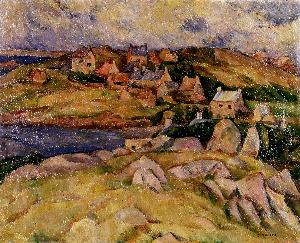Morita Tsunetomo
森田 恒友;Morita Tsunetomo
Place: Tamai
Born: 1881
Death: 1933
Biography:
Morita Tsunetomo was a Japanese painter in the yōga style, known primarily for his landscapes. Born in Tamai, Japan in 1881 and died in Tokyo in 1933, he began his studies at the Tokyo Art School in 1904. In 1907, one of his paintings was accepted for the First Exhibition of the Ministry of Culture.
Early Career and Influences
Morita Tsunetomo's early career was marked by a fascination with Western art, particularly the Impressionist movement. He visited Paris and Brittany in 1914, where he came under the influence of modern French art. This exposure had a significant impact on his style, as evident in his landscapes that often featured bold brushstrokes and vibrant colors.
Major Works and Contributions
Some of Morita Tsunetomo's notable works include an anthology of essays and a book of art instruction, both published in 1934. His writing was published under the pseudonym 'Heiya', showcasing his versatility as an artist and writer. As a painter, he was one of the founders of the Shunyo-kai art society in 1922 and became Director of the Western Painting Department at the new Imperial Art Academy in 1929.
Artistic Style and Legacy
Morita Tsunetomo's landscapes are characterized by their use of bold colors and expressive brushwork. His style was influenced by both Japanese and Western art traditions, reflecting the cultural exchange that was taking place during his time. As a member of the yōga movement, he played an important role in introducing Western-style painting to Japan.
- He began his studies at the Tokyo Art School in 1904.
- In 1907, one of his paintings was accepted for the First Exhibition of the Ministry of Culture.
- He visited Paris and Brittany in 1914, where he came under the influence of modern French art.
- He became Director of the Western Painting Department at the new Imperial Art Academy in 1929.
who have been influenced by Morita Tsunetomo's work include Ike Taiga, a prominent Bunjinga artist, and Kanō Tan'yū, one of the foremost Kanō painters of the Tokugawa period. Morita Tsunetomo's legacy can be seen in his contributions to the development of Japanese landscape painting, as well as his role in introducing Western art styles to Japan. For more information on Morita Tsunetomo and other Japanese artists, visit https://Wikioo.org/@/Morita-Tsunetomo or explore the Tokyo National Museum collection at https://Wikioo.org/Art.nsf/O/A@D3CPWR.


